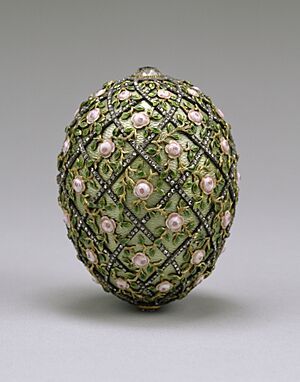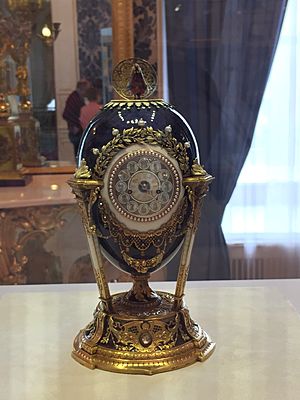Fabergé egg facts for kids
A Fabergé egg is a super fancy, jeweled egg made by the company of Peter Carl Fabergé between 1885 and 1917.
The most famous eggs were made for the Russian Tsars, Alexander III and Nicholas II. These special eggs were Easter gifts for their wives and mothers. They are known as the 'Imperial' Fabergé eggs. Fabergé's company made about 50 of these Imperial eggs, and 43 of them still exist today. Two more eggs were planned for Easter 1918, but they were never finished or delivered because of the Russian Revolution.
Contents
History of the Imperial Eggs
The very first Fabergé egg was created for Tsar Alexander III. He decided to give his wife, Empress Maria Fedorovna, an Easter egg in 1885. This was possibly to celebrate their 20th engagement anniversary.
Many people believe the Tsar was inspired by an egg owned by the Empress’s aunt, Princess Vilhelmine Marie of Denmark. This egg had fascinated Maria when she was a child. The first Fabergé egg is called the Hen Egg. It is made of gold with a white enameled "shell." This shell opens up to show a yellow-gold "yolk" inside. The yolk also opens to reveal a colorful gold hen. The hen used to hold a tiny diamond copy of the imperial crown and a small ruby pendant, but these two parts are now lost.
Empress Maria loved the gift so much! Because of this, Tsar Alexander named Fabergé a "goldsmith by special appointment to the Imperial Crown." He then ordered another egg for the next year. After that, Peter Carl Fabergé was given complete freedom to design future Imperial Easter eggs. His designs became much more detailed and amazing.
It is said that even the Tsar didn't know what the eggs would look like. The only rules were that each egg had to have a surprise inside and be totally unique. Once Fabergé approved a design, a team of skilled craftsmen would create the egg. Some of these craftsmen included Michael Perkhin, Henrik Wigström, and Erik August Kollin.
After Tsar Alexander III passed away in 1894, his son, Nicholas II, continued the tradition. He gave a Fabergé egg to both his wife, Alexandra Fedorovna, and his mother, the Dowager Empress Maria Fedorovna. Records show that out of the 50 Imperial Easter eggs, 20 were given to his wife and 30 to his mother. Eggs were made every year, except in 1904 and 1905, during the Russo-Japanese War.
Other Fabergé Eggs
The Imperial eggs became very famous. Because of this, Fabergé was asked to make similar eggs for a few private customers. These included important families like the Rothschild family and the Yusupovs. Fabergé was also asked to make twelve eggs for a rich industrialist named Alexander Kelch. However, it seems only seven of these were completed.
After the Russian Revolution in 1918, the Fabergé workshop in St. Petersburg was taken over by the government. The Fabergé family then left Russia. Since then, the Fabergé name has been sold many times. Different companies have sold egg-themed items using the Fabergé brand. For example, the Victor Mayer jewelry company made special limited edition Fabergé eggs from 1998 to 2009. Today, the Fabergé trademark is owned by Fabergé Limited, which creates jewelry with egg designs.
In 2015, the current owners of the Fabergé brand announced a new "Fabergé" egg. They called it an "Imperial Class" egg, saying it was the first of its kind in 100 years. This egg, called the Fabergé Pearl egg, was planned to be sold in Qatar.
List of Fabergé Imperial Easter Eggs
Below is a list of the amazing eggs made for the Russian Imperial family.
| Date | Egg | Image | Description | Owner | |
|---|---|---|---|---|---|
| 1885 | Hen egg |  |
Also known as the Jewelled Hen Egg, it was the first of 54 jeweled eggs made for the Russian Imperial family. The tsarina and the tsar loved the egg so much that Alexander III ordered a new egg from Fabergé every Easter. | Viktor Vekselberg | |
| 1886 | Hen egg with sapphire pendant | Also known as the Egg with hen in basket, it was made in 1886 for Alexander III, who gave it to his wife, Empress Maria Feodorovna. | LOST | ||
| 1887 | Third Imperial egg | 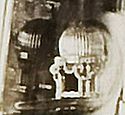 |
A jeweled yellow gold egg with a Vacheron & Constantin watch inside. It sits on its original stand. In 2014, it was bought by a private collector. | Private Collection | |
| 1888 | Cherub with chariot egg |  |
Also known as the Angel with egg in chariot, made and delivered in 1888 to Alexander III. This is one of the lost Imperial eggs, so not many details are known about it. | LOST | |
| 1889 | Nécessaire egg | Made and given to Alexander III, who presented it to his wife, Maria Feodorovna, on Easter 1889. | LOST | ||
| 1890 | Danish palaces egg |  |
Made and given to Alexander III, who presented it to his wife, Maria Feodorovna, on Easter 1890. | Matilda Geddings Gray Foundation. | |
| 1891 | Memory of Azov egg | 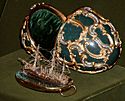 |
Kremlin Armoury, Moscow, Russia | ||
| 1892 | Diamond trellis egg | 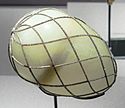 |
Private collection | ||
| 1893 | Caucasus egg | 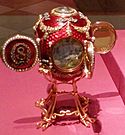 |
Matilda Geddings Gray Foundation. | ||
| 1894 | Renaissance egg |  |
Viktor Vekselberg | ||
| 1895 | Rosebud egg |  |
Viktor Vekselberg | ||
| 1895 | Blue serpent clock egg | Before March 2014, this egg was mistakenly thought to be the third Imperial egg. | Albert II of Monaco collection, Monte-Carlo, Monaco | ||
| 1896 | Rock crystal egg | Also known as the revolving miniatures egg. | Virginia Museum of Fine Arts | ||
| 1896 | Twelve monograms | 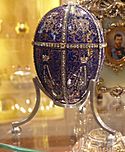 |
Also known as the Alexander III portraits egg. The surprise inside is missing. | Hillwood Museum, Washington D.C. | |
| 1897 | Imperial Coronation egg | 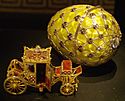 |
Viktor Vekselberg | ||
| 1897 | Mauve | Only the surprise from inside this egg has survived. | LOST Viktor Vekselberg |
||
| 1898 | Lilies of the Valley egg | 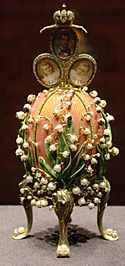 |
This egg is one of two made in the Art Nouveau style. It was given to Tsar Nicholas II on April 5 as a gift for his wife, Empress Alexandra Fyodorovna. | Viktor Vekselberg | |
| 1898 | Pelican egg | 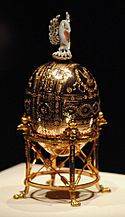 |
Virginia Museum of Fine Arts, Richmond, Virginia, USA | ||
| 1899 | Bouquet of lilies clock egg |  |
Kremlin Armoury, Moscow | ||
| 1899 | Pansy egg | Private Collection | |||
| 1900 | Trans-Siberian Railway egg | 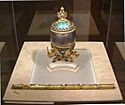 |
Kremlin Armoury, Moscow | ||
| 1900 | Cockerel egg | Viktor Vekselberg | |||
| 1901 | Basket of wild flowers | Royal Collection, London, United Kingdom | |||
| 1901 | Gatchina Palace egg |  |
Walters Art Museum, Baltimore, Maryland | ||
| 1902 | Clover leaf egg | 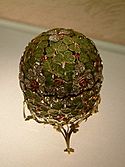 |
Kremlin Armoury, Moscow | ||
| 1902 | Empire nephrite egg | LOST | |||
| 1903 | Peter the Great egg | 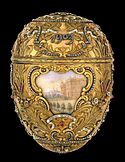 |
Virginia Museum of Fine Arts, Richmond, Virginia, USA | ||
| 1903 | Royal Danish egg | 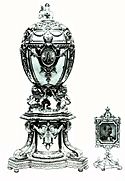 |
LOST | ||
| 1904 | No eggs made | ||||
| 1905 | No eggs made | ||||
| 1906 | Moscow Kremlin egg | 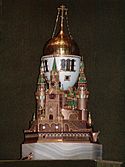 |
Kremlin Armoury, Moscow | ||
| 1906 | Swan egg | Edouard and Maurice Sandoz Foundation, Switzerland | |||
| 1907 | Rose trellis egg | 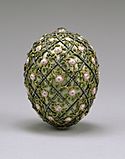 |
Walters Art Museum, Baltimore, Maryland, USA | ||
| 1907 | Love trophies egg or 'Cradle with garlands' egg | Private Collection | |||
| 1908 | Alexander Palace egg | 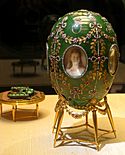 |
Kremlin Armoury, Moscow | ||
| 1908 | Peacock egg) | Edouard and Maurice Sandoz Foundation, Switzerland | |||
| 1909 | Standart yacht egg | 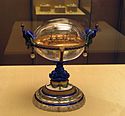 |
Kremlin Armoury, Moscow | ||
| 1909 | Alexander III commemorative egg |  |
LOST | ||
| 1910 | Colonnade egg | Royal Collection, London | |||
| 1910 | Alexander III equestrian egg) | 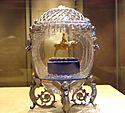 |
Kremlin Armoury, Moscow | ||
| 1911 | Fifteenth anniversary egg | Viktor Vekselberg | |||
| 1911 | Bay tree egg | 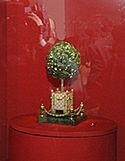 |
Also known as the Orange tree egg. | Viktor Vekselberg | |
| 1912 | Tsarevich egg |  |
Virginia Museum of Fine Arts, Richmond, Virginia | ||
| 1912 | Napoleonic egg |  |
Matilda Geddings Gray Foundation. Displayed at the Metropolitan Museum of Art, New York. | ||
| 1913 | Romanov tercentenary egg | 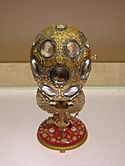 |
Kremlin Armoury, Moscow | ||
| 1913 | Winter egg | The State of Qatar | |||
| 1914 | Mosaic egg | Royal Collection, London | |||
| 1914 | Grisaille egg or Catherine the Great egg | 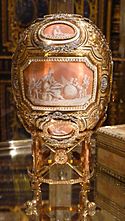 |
This egg was made by Henrik Wigström, Fabergé's last main craftsman. Nicholas II gave it to his mother, Maria Fedrovna. Its surprise (now lost) was "a mechanical sedan chair, carried by two blackamoors, with Catherine the Great seated inside." | Hillwood Museum, Washington, D.C., USA | |
| 1915 | Red Cross with triptych egg | Cleveland Museum of Art, Cleveland, Ohio | |||
| 1915 | Red Cross with imperial portraits | 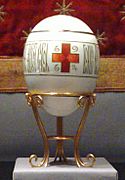 |
Virginia Museum of Fine Arts, Richmond, Virginia | ||
| 1916 | Steel military egg | 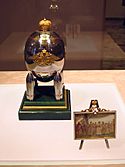 |
Kremlin Armoury, Moscow | ||
| 1916 | Order of St. George egg |  |
Made during World War I, this egg honored the Order of St. George award given to Emperor Nicholas and his son, Grand Duke Alexei Nikolaievich. This egg and the previous one had simple designs because of the war. The Order of St. George egg left Bolshevik Russia with its original owner, Dowager Empress Maria Feodorovna. | Viktor Vekselberg | |
| 1917 | Karelian birch egg | Made in 1917, this egg was supposed to be given to the Tsar's mother, Empress Maria Feodorovna, that Easter. But the February Revolution happened, and Nicholas II had to give up his throne on March 15. Fabergé sent the Tsar an invoice for the egg, addressing him as "Mr. Romanov, Nikolai Aleksandrovich." Nicholas paid for it. The egg was sent to Grand Duke Michael Alexandrovich's palace to be given to the empress, but the duke left before it arrived. The egg stayed in the palace until it was taken during the October Revolution. | Alexander Ivanov. Displayed at Ivanov's Fabergé Museum in Baden-Baden, Germany. | ||
| 1917 | Constellation egg |  |
Because of the Russian Revolution, this egg was never finished or given to Tsar Nicholas's wife, Tsaritsa Alexandra Feodorovna. Two eggs claim to be the Constellation egg: one at Fersman Mineralogical Museum in Moscow and another owned by Alexander Ivanov at his Fabergé Museum in Baden-Baden, Germany. | Fersman Mineralogical Museum, Moscow or the Fabergé Museum in Baden-Baden. | |
Images for kids
See also
 In Spanish: Huevo de Fabergé para niños
In Spanish: Huevo de Fabergé para niños


